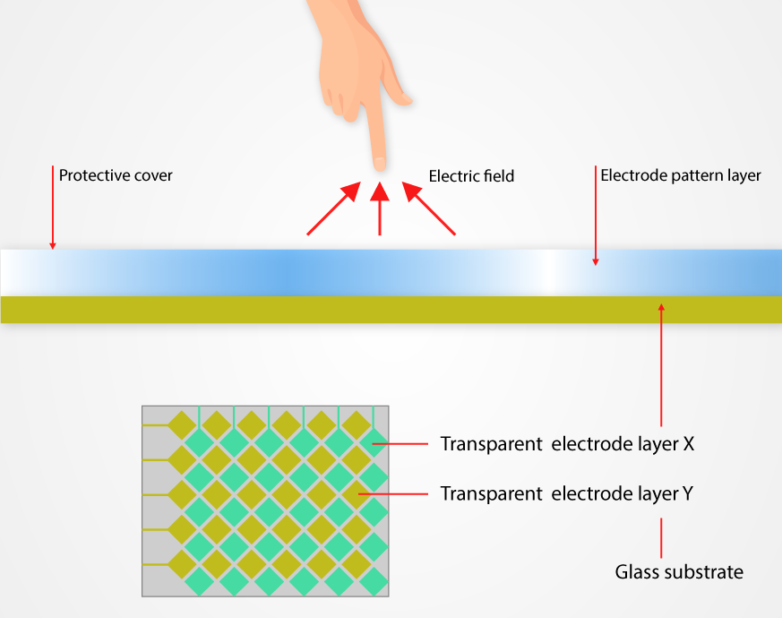Do you know? You don’t really have to touch your mobile’s screen to make it work. It’s because… Read it below🙂
Touch screens are pretty much everywhere. From smartwatches and smartphones to lifts and aeroplanes, it enables us to interact with devices more easily. You have probably noticed that all touch screens are not the same. The touch screens in ATMs are different from the touch screens on your smartphones. There are different types of touch screens, but here we mainly focus on two types of touch screens: resistive and capacitive. And today we are going to discuss how these things work.
Resistive Touchscreen
Remember the touch screen in ATMs that is bulky, slow to respond, and requires you to press harder to activate? That is a resistive touch screen. The name itself suggests it has something to do with the resistance and current of a material.
It consists of two transparent layers. The top layer is made from a few flexible materials and is generally made up of plastic materials, whereas the bottom layer is rigid and made up of glass. To make these layers conductive, indium tin oxide (ITO) is coated horizontally in one layer and vertically in another layer. These layers are separated by non-conductive spaces called spacers.
The spacers help to prevent false touch detection.
When the screen is ON, current flows through these horizontal and vertical grids of ITO. Because of spacers, the resistance is high between these two layers. When someone presses the screen, the first layer bends and touches the bottom layer. Because of it, there is a change in resistance at that point, which is detected by a micro-controller. The micro-controller finds the location of a touch by using the x and y coordinates of the grid. Further
Action is taken based on which option was shown up at that touch position.

Merits of Resistive Touch Screen
·Supports all types of touch (figures, gloves, pens, and so on).
·Low cost and simple design.
·They are more durable.
Demerits of Resistive Touch Screen
·Less responsive than the capacitive touch screen
·Multi-touch is not supported.
·It has a low brightness and cannot be used in direct sunlight.
Capacitive Touch Screen
The name suggests that it has to do something with the capacitance of materials. Don’t know what it is? Capacitance is basically the ability of a material to store an electrical charge. It is also further divided into two types: projected capacitive touch screens and surface capacitive touch screens. On our smartphones and tablets, we have projected capacitive touch screens, so we are going to discuss it.
It consists of two transparent layers. The upper layer is generally composed of polyester. Both layers are coated with Indium Tin Oxide in a diamond grid pattern to make them conduct. A transparent insulator is inserted between these two layers. When the screen is on, electricity flows through these girds, forming a capacitor with its electric field around it. When a conducting material (like your finger) touches the screen, the fields start to travel through your fingers. Because of that, the capacitance of that touch location increases. The micro-controller detects the change in capacitance of that area and finds out the exact location of touch with the help of grids. Further action is taken based on which option was shown on the touch areas.
Actually, you don’t really have to touch the screen to make it work. Since it’s not necessary to touch the screen to change the capacitance, you just have to move your finger closer to the screen to make it work. But the calibration is set so precisely that you have to bring your finger really close (I mean really really close) to the screen to make it work. You never touch the touch glass, you only touch the protective glass.

Do other conductive materials (like iron nails) work with capacitive touch screens?
All conductive materials work with capacitive touch screens. But the manufacturer has set a threshold for the minimum area to be detectable. The iron nails have a very small area, so they will not work with capacitive touch screens. But the spoon, which has a greater surface area, yeah, it will work.
Merits of Capacitive touch Screen
· Easy to use
· Provide multi-touch
· The screen will not bend and you will not have to apply greater pressure like in resistive touch screen, so it can run for a long time.
· The screen has greater contrast, so it can be used in direct sunlight too.
Demerits of Capacitive Touch Screen
· The upper glass is more prone to cracking. Though it will still work, it will decrease its beauty.
· Only work with conducting materials like fingers.
· In comparison to a resistive touch screen, it is costlier.


0 Comments